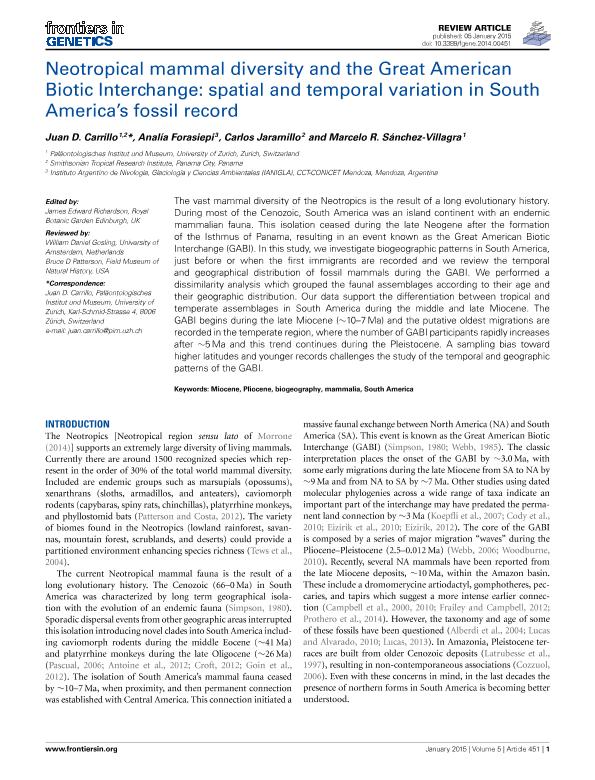Mostrar el registro sencillo del ítem
dc.contributor.author
Carrillo, Juan Carlos

dc.contributor.author
Forasiepi, Analia Marta

dc.contributor.author
Jaramillo, Carlos

dc.contributor.author
Sánchez Villagra, Marcelo R.
dc.date.available
2018-09-12T18:04:30Z
dc.date.issued
2015-01
dc.identifier.citation
Carrillo, Juan Carlos; Forasiepi, Analia Marta; Jaramillo, Carlos; Sánchez Villagra, Marcelo R.; Neotropical mammal diversity and the great American biotic interchange: Spatial and temporal variation in South America's fossil record; Frontiers Research Foundation; Frontiers in Genetics; 5; DEC; 1-2015; 1-11
dc.identifier.issn
1664-8021
dc.identifier.uri
http://hdl.handle.net/11336/59347
dc.description.abstract
The vast mammal diversity of the Neotropics is the result of a long evolutionary history. During most of the Cenozoic, South America was an island continent with an endemic mammalian fauna. This isolation ceased during the late Neogene after the formation of theIsthmus of Panama, resulting in an event known as the Great American Biotic Interchange (GABI). In this study, we investigate biogeographic patterns in South America, just before or when the first immigrants are recorded and we review the temporal and geographical distribution of fossil mammals during the GABI. We performed a dissimilarity analysis which grouped the faunal assemblages according to their age and their geographic distribution. Our data supports the differentiation between tropical and temperate assemblages in South America during the middle and late Miocene. The GABI begins during the late Miocene (~10-7 Ma) and the putative oldest migrations are recorded in the temperate region, where the number of GABI participants rapidly increases after ~5 Ma and this trend continues during the Pleistocene. A sampling bias towards higher latitudes and younger records challenges the study of the temporal and geographic patterns of the GABI.
dc.format
application/pdf
dc.language.iso
eng
dc.publisher
Frontiers Research Foundation
dc.rights
info:eu-repo/semantics/openAccess
dc.rights.uri
https://creativecommons.org/licenses/by-nc-sa/2.5/ar/
dc.subject
Biogeography
dc.subject
Great American Biotic Interchange
dc.subject
Mammalia
dc.subject
Neotropics
dc.subject
South America
dc.subject.classification
Meteorología y Ciencias Atmosféricas

dc.subject.classification
Ciencias de la Tierra y relacionadas con el Medio Ambiente

dc.subject.classification
CIENCIAS NATURALES Y EXACTAS

dc.title
Neotropical mammal diversity and the great American biotic interchange: Spatial and temporal variation in South America's fossil record
dc.type
info:eu-repo/semantics/article
dc.type
info:ar-repo/semantics/artículo
dc.type
info:eu-repo/semantics/publishedVersion
dc.date.updated
2018-08-28T19:04:09Z
dc.journal.volume
5
dc.journal.number
DEC
dc.journal.pagination
1-11
dc.journal.pais
Suiza

dc.journal.ciudad
Lausanne
dc.description.fil
Fil: Carrillo, Juan Carlos. Universitat Zurich; Suiza. Smithsonian Tropical Research Institute; Panamá
dc.description.fil
Fil: Forasiepi, Analia Marta. Consejo Nacional de Investigaciones Científicas y Técnicas. Centro Científico Tecnológico Conicet - Mendoza. Instituto Argentino de Nivología, Glaciología y Ciencias Ambientales. Provincia de Mendoza. Instituto Argentino de Nivología, Glaciología y Ciencias Ambientales. Universidad Nacional de Cuyo. Instituto Argentino de Nivología, Glaciología y Ciencias Ambientales; Argentina
dc.description.fil
Fil: Jaramillo, Carlos. Smithsonian Tropical Research Institute; Panamá
dc.description.fil
Fil: Sánchez Villagra, Marcelo R.. Universitat Zurich; Suiza
dc.journal.title
Frontiers in Genetics
dc.relation.alternativeid
info:eu-repo/semantics/altIdentifier/doi/https://dx.doi.org/10.3389/fgene.2014.00451
dc.relation.alternativeid
info:eu-repo/semantics/altIdentifier/url/https://www.frontiersin.org/articles/10.3389/fgene.2014.00451/full
Archivos asociados
